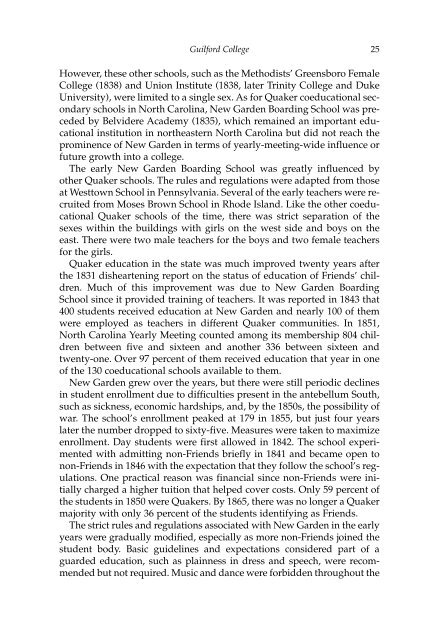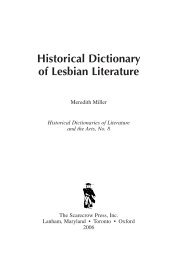Founded by Friends : the Quaker heritage of fifteen - Scarecrow Press
Founded by Friends : the Quaker heritage of fifteen - Scarecrow Press
Founded by Friends : the Quaker heritage of fifteen - Scarecrow Press
You also want an ePaper? Increase the reach of your titles
YUMPU automatically turns print PDFs into web optimized ePapers that Google loves.
Guilford College 25<br />
However, <strong>the</strong>se o<strong>the</strong>r schools, such as <strong>the</strong> Methodists’ Greensboro Female<br />
College (1838) and Union Institute (1838, later Trinity College and Duke<br />
University), were limited to a single sex. As for <strong>Quaker</strong> coeducational secondary<br />
schools in North Carolina, New Garden Boarding School was preceded<br />
<strong>by</strong> Belvidere Academy (1835), which remained an important educational<br />
institution in nor<strong>the</strong>astern North Carolina but did not reach <strong>the</strong><br />
prominence <strong>of</strong> New Garden in terms <strong>of</strong> yearly-meeting-wide influence or<br />
future growth into a college.<br />
The early New Garden Boarding School was greatly influenced <strong>by</strong><br />
o<strong>the</strong>r <strong>Quaker</strong> schools. The rules and regulations were adapted from those<br />
at Westtown School in Pennsylvania. Several <strong>of</strong> <strong>the</strong> early teachers were recruited<br />
from Moses Brown School in Rhode Island. Like <strong>the</strong> o<strong>the</strong>r coeducational<br />
<strong>Quaker</strong> schools <strong>of</strong> <strong>the</strong> time, <strong>the</strong>re was strict separation <strong>of</strong> <strong>the</strong><br />
sexes within <strong>the</strong> buildings with girls on <strong>the</strong> west side and boys on <strong>the</strong><br />
east. There were two male teachers for <strong>the</strong> boys and two female teachers<br />
for <strong>the</strong> girls.<br />
<strong>Quaker</strong> education in <strong>the</strong> state was much improved twenty years after<br />
<strong>the</strong> 1831 disheartening report on <strong>the</strong> status <strong>of</strong> education <strong>of</strong> <strong>Friends</strong>’ children.<br />
Much <strong>of</strong> this improvement was due to New Garden Boarding<br />
School since it provided training <strong>of</strong> teachers. It was reported in 1843 that<br />
400 students received education at New Garden and nearly 100 <strong>of</strong> <strong>the</strong>m<br />
were employed as teachers in different <strong>Quaker</strong> communities. In 1851,<br />
North Carolina Yearly Meeting counted among its membership 804 children<br />
between five and sixteen and ano<strong>the</strong>r 336 between sixteen and<br />
twenty-one. Over 97 percent <strong>of</strong> <strong>the</strong>m received education that year in one<br />
<strong>of</strong> <strong>the</strong> 130 coeducational schools available to <strong>the</strong>m.<br />
New Garden grew over <strong>the</strong> years, but <strong>the</strong>re were still periodic declines<br />
in student enrollment due to difficulties present in <strong>the</strong> antebellum South,<br />
such as sickness, economic hardships, and, <strong>by</strong> <strong>the</strong> 1850s, <strong>the</strong> possibility <strong>of</strong><br />
war. The school’s enrollment peaked at 179 in 1855, but just four years<br />
later <strong>the</strong> number dropped to sixty-five. Measures were taken to maximize<br />
enrollment. Day students were first allowed in 1842. The school experimented<br />
with admitting non-<strong>Friends</strong> briefly in 1841 and became open to<br />
non-<strong>Friends</strong> in 1846 with <strong>the</strong> expectation that <strong>the</strong>y follow <strong>the</strong> school’s regulations.<br />
One practical reason was financial since non-<strong>Friends</strong> were initially<br />
charged a higher tuition that helped cover costs. Only 59 percent <strong>of</strong><br />
<strong>the</strong> students in 1850 were <strong>Quaker</strong>s. By 1865, <strong>the</strong>re was no longer a <strong>Quaker</strong><br />
majority with only 36 percent <strong>of</strong> <strong>the</strong> students identifying as <strong>Friends</strong>.<br />
The strict rules and regulations associated with New Garden in <strong>the</strong> early<br />
years were gradually modified, especially as more non-<strong>Friends</strong> joined <strong>the</strong><br />
student body. Basic guidelines and expectations considered part <strong>of</strong> a<br />
guarded education, such as plainness in dress and speech, were recommended<br />
but not required. Music and dance were forbidden throughout <strong>the</strong>
















